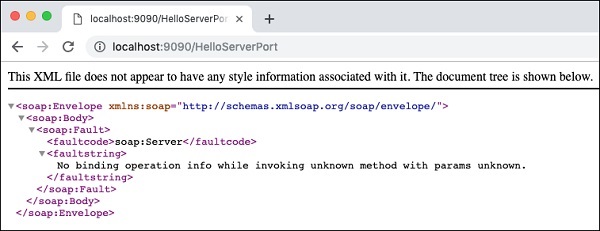
Apache CXF With POJO
Apache CXF with JAX-WS
Apache CXF with WSDL First
Apache CXF With JAX-RS
Apache CXF With JMS
Apache CXF Conclusion
Apache CXF Useful Resources
Apache CXF - Creating WSDL Based Server
We're creating a maven project using Eclipse. Go to New > Maven Project. Check the Create a simple project option. and choose the following properties −
groupid − com.tutorialspoint
artifactId − cxf-pojo
version − 1.0
After the completion of the wizard, you will find the appropriate folder structure created in your current folder along with pom.xml file.
Developing Server
Developing server application is once again trivial. Here, we will use the CXF supplied Endpoint class to publish our service. This is done in the following two lines of code −
HelloWorldPortType implementor = new HelloWorldImpl();
Endpoint.publish("http://localhost:9090/HelloServerPort",
implementor,
new LoggingFeature());
First, we create an object of our service implementor class - HelloWorldImpl. Then, we pass this reference as a second parameter to the publish method. The first parameter is the address to which the service is published - the clients would use this URL to access the service. The entire source for the server application is given here −
Server.java
package com.tutorialspoint.helloworld;
import org.apache.cxf.feature.LoggingFeature;
import jakarta.xml.ws.Endpoint;
public class Server {
public static void main(String[] args) throws Exception {
HelloWorldPortType implementor = new HelloWorldImpl();
Endpoint.publish("http://localhost:9090/HelloServerPort",
implementor,
new LoggingFeature());
System.out.println("Server ready...");
Thread.sleep(5 * 60 * 1000);
System.out.println("Server exiting");
System.exit(0);
}
}
To build this server class you will need to add a build profile in your pom.xml. This is shown below −
<profile>
<id>server</id>
<build>
<defaultGoal>test</defaultGoal>
<plugins>
<plugin>
<groupId>org.codehaus.mojo</groupId>
<artifactId>exec-maven-plugin</artifactId>
<version>1.6.0</version>
<executions>
<execution>
<phase>test</phase>
<goals>
<goal>java</goal>
</goals>
<configuration>
<mainClass>
com.tutorialspoint.helloworld.Server
</mainClass>
</configuration>
</execution>
</executions>
</plugin>
</plugins>
</build>
<dependencies>
<dependency>
<groupId>org.apache.cxf</groupId>
<artifactId>cxf-rt-transports-http-jetty</artifactId>
<version>3.3.0</version>
</dependency>
</dependencies>
</profile>
Note that the fully qualified name of the Server class is specified in the configuration. Also, the dependency tag specifies that we will be using the embedded jetty web server to deploy our server application.
Deploying Server
Finally, to deploy the server application, you will need to make one more modification in pom.xml to setup your application as a web application. The code that you need to add into your pom.xml is given below −
<defaultGoal>install</defaultGoal>
<pluginManagement>
<plugins>
<plugin>
<artifactId>maven-war-plugin</artifactId>
<version>3.2.2</version>
<configuration>
<webXml>src/main/webapp/WEB-INF/web.xml</webXml>
<webResources>
<resource>
<directory>src/main/resources</directory>
<targetPath>WEB-INF</targetPath>
<includes>
<include>*.wsdl</include>
</includes>
</resource>
</webResources>
</configuration>
</plugin>
</plugins>
</pluginManagement>
Before you deploy the application, you need to add two more files to your project. These are shown in the screenshot below −

These files are CXF standard files which define the mapping for CXFServlet. The code within the web.xml file is shown here for your quick reference −
web.xml
<web-app xmlns = "http://java.sun.com/xml/ns/javaee"
xmlns:xsi = "http://www.w3.org/2001/XMLSchema-instance" version="2.5"
xsi:schemaLocation = "http://java.sun.com/xml/ns/javaee
http://java.sun.com/xml/ns/javaee/web-app_2_5.xsd">
<display-name>cxf</display-name>
<servlet>
<description>Apache CXF Endpoint</description>
<display-name>cxf</display-name>
<servlet-name>cxf</servlet-name>
<servlet-class>
org.apache.cxf.transport.servlet.CXFServlet
</servlet-class>
<load-on-startup>1</load-on-startup>
</servlet>
<servlet-mapping>
<servlet-name>cxf</servlet-name>
<url-pattern>/services/*</url-pattern>
</servlet-mapping>
<session-config>
<session-timeout>60</session-timeout>
</session-config>
</web-app>
In the cxf-servlet.xml you declare the properties for your service's endpoint. This is shown in the code snippet below −
cxf-servlet.xml
<beans xmlns="http://www.springframework.org/schema/beans"
xmlns:xsi="http://www.w3.org/2001/XMLSchema-instance"
xmlns:jaxws="http://cxf.apache.org/jaxws"
xsi:schemaLocation="http://www.springframework.org/schema/beans
http://www.springframework.org/schema/beans/spring-beans-2.0.xsd
http://cxf.apache.org/jaxws
http://cxf.apache.org/schemas/jaxws.xsd">
<jaxws:endpoint xmlns:helloworld = "https://www.tutorialspoint.com/"
id = "helloHTTP"
address = "http://localhost:9090/HelloServerPort"
serviceName = "helloworld:HelloServiceService"
endpointName = "helloworld:HelloServicePort">
</jaxws:endpoint>
</beans>
Here we define the id for our service endpoint, the address on which the service will be available, the service name and the endpoint name. Now, you understand how your service gets routed and processed by a CXF servlet.
The Final pom.xml
The pom.xml includes a few more dependencies. Rather than describing all the dependencies, we have included the final version of pom.xml below −
pom.xml
<?xml version = "1.0" encoding = "UTF-8"?>
<project xmlns = "http://maven.apache.org/POM/4.0.0"
xmlns:xsi = "http://www.w3.org/2001/XMLSchema-instance"
xsi:schemaLocation = "http://maven.apache.org/POM/4.0.0
http://maven.apache.org/xsd/maven-4.0.0.xsd">
<modelVersion>4.0.0</modelVersion>
<groupId>com.tutorialspoint</groupId>
<artifactId>cxf-pojo</artifactId>
<version>1.0</version>
<packaging>jar</packaging>
<properties>
<project.build.sourceEncoding>UTF-8</project.build.sourceEncoding>
<maven.compiler.source>24</maven.compiler.source>
<maven.compiler.target>24</maven.compiler.target>
<cxf.rt.version>4.1.3</cxf.rt.version>
</properties>
<build>
<defaultGoal>install</defaultGoal>
<pluginManagement>
<plugins>
<plugin>
<artifactId>maven-war-plugin</artifactId>
<version>3.2.2</version>
<configuration>
<webXml>src/main/webapp/WEB-INF/web.xml</webXml>
<webResources>
<resource>
<directory>src/main/resources</directory>
<targetPath>WEB-INF</targetPath>
<includes>
<include>*.wsdl</include>
</includes>
</resource>
</webResources>
</configuration>
</plugin>
</plugins>
</pluginManagement>
<plugins>
<plugin>
<groupId>org.apache.cxf</groupId>
<artifactId>cxf-codegen-plugin</artifactId>
<version>${cxf.rt.version}</version>
<executions>
<execution>
<id>generate-sources</id>
<phase>generate-sources</phase>
<configuration>
<wsdlOptions>
<wsdlOption>
<wsdl>src/main/resources/Hello.wsdl</wsdl>
<faultSerialVersionUID>1</faultSerialVersionUID>
</wsdlOption>
</wsdlOptions>
</configuration>
<goals>
<goal>wsdl2java</goal>
</goals>
</execution>
</executions>
</plugin>
</plugins>
</build>
<profiles>
<profile>
<id>server</id>
<build>
<defaultGoal>test</defaultGoal>
<plugins>
<plugin>
<groupId>org.codehaus.mojo</groupId>
<artifactId>exec-maven-plugin</artifactId>
<version>1.6.0</version>
<executions>
<execution>
<phase>test</phase>
<goals>
<goal>java</goal>
</goals>
<configuration>
<mainClass>
com.tutorialspoint.helloworld.Server
</mainClass>
</configuration>
</execution>
</executions>
</plugin>
</plugins>
</build>
<dependencies>
<dependency>
<groupId>org.apache.cxf</groupId>
<artifactId>cxf-rt-transports-http-jetty</artifactId>
<version>${cxf.rt.version}</version>
</dependency>
</dependencies>
</profile>
</profiles>
<dependencies>
<dependency>
<groupId>org.apache.cxf</groupId>
<artifactId>cxf-rt-features-logging</artifactId>
<version>${cxf.rt.version}</version>
<scope>test</scope>
</dependency>
<dependency>
<groupId>org.apache.cxf</groupId>
<artifactId>cxf-rt-frontend-simple</artifactId>
<version>${cxf.rt.version}</version>
</dependency>
<dependency>
<groupId>org.apache.cxf</groupId>
<artifactId>cxf-rt-transports-http</artifactId>
<version>${cxf.rt.version}</version>
</dependency>
<dependency>
<groupId>org.apache.cxf</groupId>
<artifactId>cxf-rt-frontend-jaxws</artifactId>
<version>${cxf.rt.version}</version>
</dependency>
<!-- Jetty is needed if you're using the CXFServlet -->
<dependency>
<groupId>org.apache.cxf</groupId>
<artifactId>cxf-rt-transports-http-jetty</artifactId>
<version>${cxf.rt.version}</version>
</dependency>
</dependencies>
</project>
Running the HelloWorld Service
Now, you are ready to run the web app. In the command window, run the build script using the following command.
mvn clean install
This will generate the appropriate Apache CXF classes from your wsdl, compile your Apache CXF classes, deploy the server on the embedded jetty server and run your application.
You will see the following message on the console −
INFO: Setting the server's publish address to be http://localhost:9090/HelloServerPort Server ready...
As before, you can test the server by opening the server URL in your browser.

As we did not specify any operation, only a fault message is returned to the browser by our application. Now, try adding the ?wsdl to your URL and you will see the following output −

So our server application is running as expected. You may use the SOAP Client such as Postman described earlier to further test your service.